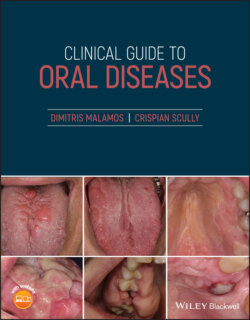Читать книгу Clinical Guide to Oral Diseases - Crispian Scully - Страница 32
Case 2.7
ОглавлениеFigure 2.7
CO: A healthy young man of 18 years of age presented to the Emergency Dental Clinic for a bluish swelling on his lower lip.
HPC: The lesion appeared, one week ago, following a facial injury during a basketball game as a small, asymptomatic soft lump. The lesion has become bigger over the last three days when the patient bit accidentally his lip during eating again.
PMH: He has no serious medical problems apart from an atopic dermatitis, since the age of six, which was treated with topical glucocorticoid cream. Being a basketball player, his regular blood check‐up did not reveal any bleeding conditions, while his habits do not include smoking or drinking.
OE: A large soft swelling of the inner surface of the lower lip. The swelling was painless and fluctuant with bluish color and with a size of 2 cm maximum in diameter and a superficial ulcer on top (Figure 2.7). It was associated with swollen minor salivary glands and topical ecchymosis due to previous trauma. No bruises or ecchymoses in other parts of his mouth and skin were found.
Q1 What is his most likely diagnosis?
1 Hemangioma
2 Mucocele
3 Hematoma
4 Fibroma (traumatic)
5 Lip abscess
Answers:
1 No
2 Mucocele is a common soft, cystic‐like swelling seen on both lips but mainly in the lower caused by an extravagation of saliva into the submucosa due to the damage of minor salivary glands after a local injury. A repeated trauma increases mucocele size and changes its color from translucent to bluish, due to the accumulation of blood within the saliva and hematoma formation at the base of lesion as is exactly seen in this patient.
3 No
4 No
5 No
Comments: In contrast to the mucocele, hemangioma appears very early in the patient's lifewhile the hematoma is a blue discoloration which faints over the time; Fibroma is a soft but not fluctuated lesion; while abscess is a fluctuated, inflamed swelling containing pus and therefore its color ranges from red to yellow but rarely blue.
Q2 Which is/are the histological difference(s) between a mucous extravasation and retention mucocele?
1 Inflammation (type/density)
2 Epithelial lining
3 Associated closely with salivary acini
4 Location within submucosa
5 Presence of foam macrophages
Answers:
1 No
2 Epithelium lines the lumen of the mucous retention but not the extravasation cyst whose lining is from granulation tissue.
3 No
4 No
5 Macrophages with large foam or vacuolated cytoplasm are abundant within the mucous and the surrounded lumen of granulation tissue in mucous extravasation rather than retention cysts.
Comments: Both cysts are located superficially or deeply within the underlying connective tissue of the oral mucosa, where a mixed chronic inflammation and a few scattered ducts are seen.
Q3 Which of the cysts, found in the oral mucosa, do not have epithelial lining?
1 Ranula
2 Stafne cyst
3 Dermoid cyst
4 Aneurysmal cysts
5 Mucous extravasation cyst
Answers:
1 No
2 No
3 No
4 No
5 Mucous extravasation cyst is the answer.
Comments: Ranula and dermoid cysts, additionally to mucous extravasation cysts, are also found within the oral cavity but lined with stratified squamous epithelium. On the other hand, the Stafne cyst and aneurysmatic cyst are real pseudocysts that are not located within the oral mucosa but are found in the lower jaw, close to the apex of molars and at the angle of the mandible respectively.
